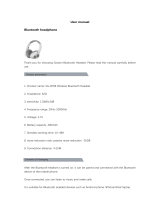
3. FEATURES
• A thin speaker designed to be curved to follow the contours of the body can be fitted firmly
around the waist with an elastic Belt and provides freedom of movement.
• Since the power switch and volume control are located in the center of the Main PA unit, the
Main PA unit can be operated easily and placed on either side of the body.
• Equipped with a 10 cm (4") cone speaker that uses a light and highly functional neodymium
magnet, allowing for sound to travel over a wide range (with 180° directivity) and ensuring the
system’s volume is loud enough to be used even outdoors.
• Connecting a commercially available audio player to the auxiliary input terminal (AUX) allows
music to be reproduced while the user is talking. If you use a Bluetooth-enabled smartphone
or audio player, you can play music while talking
• Operates on six AA-type alkaline (LR-6) batteries. Using the supplied Battery Spacer allows
the system to be powered using just four AA-type batteries, though the volume will not be as
loud as when six batteries are used.
• Commercially available nickel-metal hydride batteries (HR15/51) can also be used to power
the Personal PA, providing an environmentally friendly and economical choice.
• The Belt also contains a pouch, which permits storage of such items as an audio player, spare
batteries or the Battery Spacer.
4. PRECAUTIONS WHEN USING
• The Personal PA is not waterproofed. Avoid using it in locations where it could be exposed to
rain or splashing from water.
• Should any of the following irregularities occur, immediately turn off the power and consult
your TOA dealer. Continuing to use the product without following this instruction may cause a
malfunction.
·
When water or foreign objects get inside the product
·
When sound is not produced (after confirming batteries are inserted properly and kept fully
charged)
• Do not leave the product in damp or dusty places, or where it is subjected to direct sunlight,
nor near heaters or in cars where the windows are closed, or somewhere where it can be
exposed to oily fumes or steam. Any of these can cause malfunctions.
• When using indoors, the influence of such things as reverberations from walls or ceilings can
make it more likely to generate feedback* compared with when the product is used outdoors,
and this makes it impossible to increase the volume. When using indoors, set the volume at 5
or lower. (Conditions vary according to the user’s environment.)
• Do not use the product with sound distorted for a long time. The Main PA unit can become
overheated, possibly leading to malfunctions.
• When using a mobile phone near this product, noise may be produced, but this is not a
malfunction. Keep mobile phones as far away as possible from the product.
• Suddenly moving from a cold outdoors area into a warm interior setting may cause water
(condensation) to build up inside the product. Caution is urged as condensation may cause
malfunctions.
• When using in public places, take care not to become a nuisance for others nearby.
• To clean, be sure to first switch off the power, then wipe with a dry cloth. When extremely dirty,
use a soft cloth dampened in neutral detergent. Never use benzene, thinner or chemically-
treated towels, which may damage the product’s finish.
* Feedback is a squeal or howl from speaker caused by speaker sound entering the
microphone, which is amplified by the amplifier again and is further output from the speaker.


















